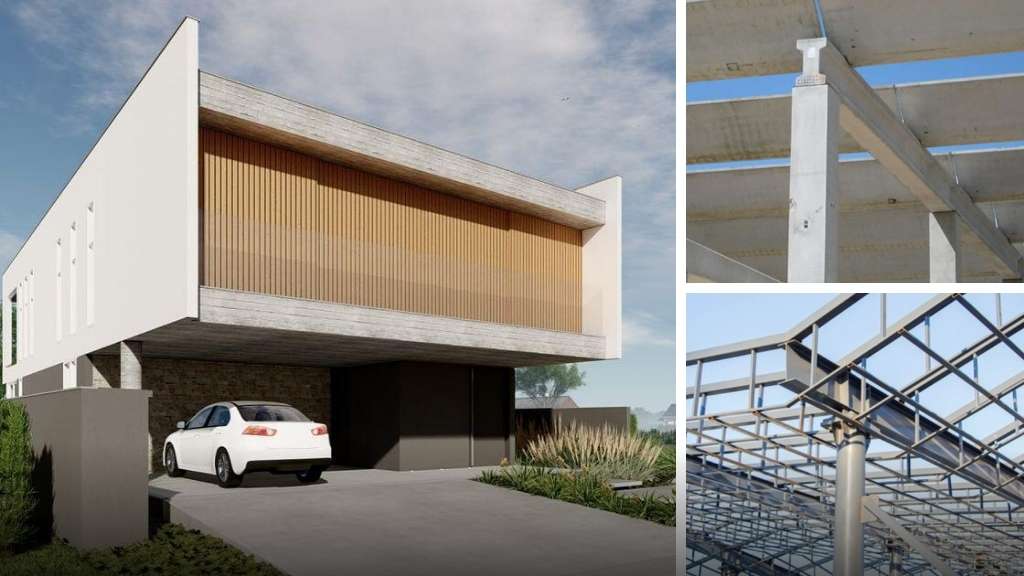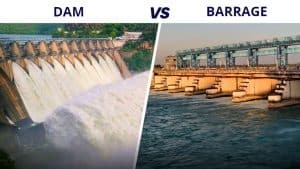
The Overview of Different Types of Beams in Construction
Buildings and structures are constructed with a particular set of different types of beams. These are structural elements that can withstand shear forces, bending moments, and vertical loads. Along their length, beams transfer loads to their endpoints, such as walls, columns, and foundations, among other things. Based on their support method, cross-section shape (profile), length, and material, the different types of beams that are utilised in the construction of buildings will be the subject of discussion in this article.
Let’s Understand The Definition of a Beam
A beam structure, or simply a beam, is a type of Beam that is used in engineering and construction to provide an effective load path that distributes the weight of the building evenly throughout its foundation. These beams support the building by resisting the load’s pressure without being bent. As the force is applied to the axis, beams resist it in a lateral direction.
How Many Types of Beams Are Used In Construction?
Beams are classified under 6 categories under which the different types of beams exist:
1.Support conditions
- Simply supported beams
- Fixed beams
- Cantilever beams
- Continuous beams
2. Construction materials
- Reinforced concrete beams
- Steel beams
- Timber beams
- Composite beams
3. Cross-section shapes
- Reinforced concrete cross-sectional beams
- Rectangular beams
- T-section beams
- L-section beams
- Steel cross-sectional beams
- Square
- Tubular
- Circular
- C-shaped
- H-shaped
- T-shaped
- I-shaped
4. Geometry
- Straight beams
- Curved beams
- Tapered beams
5. Equilibrium condition
- Statically determinate beams
- Statically indeterminate beams
6. Construction methods
- Cast in-situ concrete beams
- Precast concrete beams
- Prestressed concrete beams
7. Other different types of beams
- Deep beam
- Girder
Detailed Description of Different Types of Beams
1. Simply Supported Beams
One of the simplest structural components is the simply supported beam, whose free-rotating ends rest on supports. On one end, it has roller support, and on the other, it has pinned support. It withstands shearing and bending based on the assigned load.
2. Fixed Beams
Fixed beams are a common type of structural elements used in construction. They are designed to resist bending moments and shear forces, providing stability and support for the overall structure. Fixed beams are typically secured at both ends, making them more rigid than simply supported beams. They are often used in building frames, bridges, and other large-scale construction projects.
3. Cantilever Beams
If a shaft is fixed toward one side and set to be free at the opposite end, it is named a cantilever beam. The load is distributed by the beam before being pushed back to the support by a moment and shear stress. These types of beams help in the making of bay windows, bridges, and balconies.
4. Continuous Beams
Continuous beams are a type of structural element used in construction that spans across multiple supports. They are designed to distribute loads evenly and resist bending moments and shear forces. Continuous beams offer greater strength and stability than simply supported beams, making them suitable for large-scale structures such as bridges and buildings. They are often used in conjunction with fixed and cantilever beams to create a sturdy support system.
5. Reinforced Concrete Beams
These types of beams consist of concrete reinforced with steel bars or mesh to increase their strength and durability. Reinforced concrete beams are ideal for structures that require a high level of load-bearing capacity, such as bridges and multi-story buildings. They can also be used in combination with other different types of beams to create a sturdy support system.
6. Steel Beams
Steel beams are a popular type of structural element used in building frames, bridges, and other large-scale construction projects. They are also a popular choice for residential construction due to their versatility and aesthetic appeal.
7. Timber Beams
The timber beam is made of timber and has been widely used in the past. Timber beams are now commonly used in building construction due to their natural aesthetic appeal and versatility. They are lightweight, easy to work with, and renewable, making them an eco-friendly option. They are commonly used in residential and commercial construction for roof and floor framing, as well as decorative accents.
8. Composite Beams
Composite beams are developed from at least two unique kinds of materials, like steel and cement. Composite beams are important in building construction because they offer significant advantages over traditional materials. They combine the strength and durability of steel with the lightweight and ease of installation of concrete.
Composite beams can also be designed to resist fire, corrosion, and other environmental factors, making them ideal for long-term use. They are commonly used in multi-story buildings, bridges, and other large-scale structures, providing a reliable and cost-effective solution for complex construction projects.
9. Rectangular Reinforced Concrete Cross-Sectional Beams
These types of beams are an important element in building construction because they offer a high level of strength and durability. The rectangular shape provides an even distribution of load, making them suitable for supporting heavy structures. The reinforced steel within the concrete adds further strength, making them ideal for use in multi-story buildings and other large-scale construction projects. The rectangular shape also allows for easy installation and reduces the risk of cracking or warping over time.
10. T-section Reinforced Concrete Cross-sectional Beams
Most of the time, a reinforced concrete slab is used to construct this type of beam. An isolated T-beam may be constructed to improve concrete’s compressive strength on occasion. Added to that, a rearranged T-shaft can likewise be built by the prerequisites of stacking forces.
11. L-section Reinforced Concrete Cross-sectional Beams
L-shaped angle beams are frequently used to secure flooring systems to a building’s foundation due to their reliable stability and minimal structural depth. Additionally, the L-section design facilitates installation and lowers the likelihood of warping or cracking over time.
12. Steel Cross-sectional Beams
Steel beams come in a variety of cross-sectional shapes. In a given circumstance, each cross-sectional shape provides superior advantages over other shapes. These types of beams made of steel include square, circular, rectangular, I-, T-, H-, C-, and tubular shapes. Steel beams can also withstand harsh environmental conditions and resist corrosion, ensuring long-term structural integrity. They are versatile and can be easily fabricated to fit specific design requirements.
13. Straight Beams
A beam with a straight profile is called a straight beam, and straight beams make up the majority of structures. They are ideal for spanning long distances, supporting heavy loads, and resisting bending moments and shear forces. Straight beams can also be easily connected to other beams, columns, and walls, making them versatile and adaptable to different building designs and layouts.
14. Curved Beams
Curved beams are an important element in building construction because they offer both functional and aesthetic benefits. They can provide a unique design element to a structure while also allowing for greater load-bearing capacity in certain situations.
Curved beams can also offer increased resistance to bending and shear forces, making them ideal for use in bridges and other structures subjected to high stress. They are commonly used in modern architecture to create visually stunning buildings with innovative designs.
15. Tapered Beams
Tapered cross-sectional beams are an important element in building construction because they offer several advantages over traditional rectangular beams. The tapered shape reduces the weight and material required, while still providing sufficient strength to support the structure. This results in a more cost-effective and sustainable solution for construction projects. The tapered shape also allows for greater flexibility in design, making them ideal for complex building structures.
16. Statically Determinate Beams
These types of beams are important in building construction because they provide a reliable and predictable support system. They are designed so that the forces acting on them can be determined through simple static equations, making them easier to calculate and install. This reduces the risk of structural failure and ensures that the building will remain stable over time. Statically determinate beams are commonly used in residential and commercial construction, as well as in bridges and other large-scale infrastructure projects.
17. Statically Indeterminate Beams
Statically indeterminate beams are important in building construction because they allow for greater design flexibility and structural efficiency. By distributing loads across multiple points, they reduce stress on individual components, allowing for longer spans and greater load-bearing capacity. This can lead to more efficient use of materials and reduced construction costs. Statically indeterminate beams are commonly used in large-scale structures such as bridges and multi-story buildings, where their design versatility is critical to ensuring stability and safety.
18. Cast In-situ Concrete Beams
Cast in-situ beams are an important element in building construction because they offer several advantages over precast beams. They can be custom-designed to fit the specific needs of a project, allowing for greater flexibility and creativity in construction. Cast in-situ beams are also more durable, as they are cast on-site and are not subject to the stress of transportation. Additionally, they can be designed to resist fire, corrosion, and other environmental factors, providing a reliable and long-lasting solution for complex construction projects.
19. Precast Concrete Beams
Precast concrete beams are important in building construction because they offer a high level of quality control and efficiency. They are manufactured off-site, allowing for a faster installation process and reducing the risk of construction errors. Precast concrete beams are also highly durable, able to withstand environmental factors such as fire and corrosion. These types of beams come in the following varieties:
- Inverted T-beams
- T-beams
- Double T-beams, etc.
20. Prestressed Concrete Beam
The construction of prestressed concrete beams involves several steps. First, a high-strength steel strand is placed in the desired shape of the beam and anchored at each end. The concrete is then poured around the steel strand, which is pre-tensioned to a specific level before the concrete is cured. This pre-tensioning process creates a compressive force in the concrete, which counteracts the tensile forces that the beam will experience during use.
These types of beams have a high load-carrying capacity, which allows for longer spans and fewer support columns, resulting in more open and flexible building designs. They also have a longer service life than traditional reinforced concrete beams, which reduces maintenance and replacement costs over time.
21. Deep Beams
Deep beams are structural elements that are used to span relatively short distances whereas a regular beam would be too shallow to provide adequate strength and stiffness. The depth of the beam is usually at least twice its width and can be up to five times its width. They are often constructed with a web that is thicker than that of a standard beam, which increases the beam’s resistance to shear forces. Deep beams are typically cast in place and reinforced with steel bars or mesh.
These types of beams are used in buildings to provide support for transfer structures, like those found in multi-story buildings or parking garages, that require large column-free spaces. They are also used to support loads that are too heavy for standard beams to bear, such as heavy machinery or large mechanical systems. Deep beams are especially useful in seismic regions where buildings are more susceptible to lateral forces and need additional strength and stability.
22. Girders
They are horizontal structural members that support loads by transferring them to vertical members, such as columns or walls. Girders play a critical role in providing clear spans for large open spaces in buildings, such as auditoriums or gymnasiums. Girders can be made from a variety of materials, including steel, wood, and reinforced concrete.
The strength of a girder is determined by its size, shape, and material. The size of a girder is usually dictated by the length of the span it needs to support and the load it will bear. The shape of a girder can also affect its strength. For example, an I-shaped girder is stronger than a rectangular-shaped girder because it has more material at the top and bottom where the greatest stresses occur.
Girders are designed to be stiff and resist bending or deflection under load. The amount of deflection is controlled by the beam’s cross-sectional shape, depth, and the material it’s made from.
A Final Word From Propertygeek
The importance of different types of beams in constructing buildings depends on the building’s design, intended use, and load-bearing requirements. The right type of beam can ensure the structural integrity and safety of the building, making it an essential component of the construction process.
Different Types of Beams FAQs:
1. What is a beam and its types?
There are several types of beams used in engineering:
A beam that is simply supported is one whose ends are supported but have no moment resistance and can freely rotate.
A beam that is fixed or encastré (encastrated) cannot rotate and is supported on both ends.
A simple beam that extends beyond its support at one end is called overhanging.
2.What are the 3 types of load on the beam?
The following are the three types of loads on a beam:
3.
What is the best type of beam?
One of the best materials for beams is concrete. Strong forces and excessive loads can be supported by a concrete beam. Because of this, most commercial construction projects make use of them. Additionally, concrete structural beams are used to support highways and bridges.






